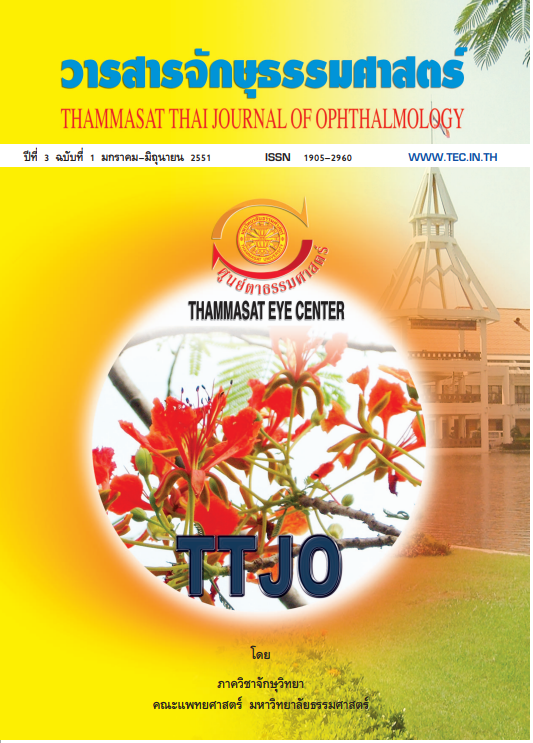Indications for Penetrating Keratoplasty in a Tertiary Care Hospital in Central Part of Thailand
Main Article Content
Abstract
Purpose : To review the leading indications for penetrating keratoplasty (PK) at Mettapracharak Eye Center from January 2002 to January 2007
Design : Retrospective, non-comparative study
Methods : Medical charts of all the patients who had undergone penetrating keratoplasty (PK) at Mettapracharak Eye Center, Nakornpathom, Thailand, from January 2002 to January 2007 were retrospectively reviewed. The indications for penetrating keratoplasty (PK) were categorized into eight diagnostic groups, which included
1. Corneal scars 2. Bullous keratopathy 3. Corneal ulcer 4. Corneal dystrophy
5. Corneal ectasia 6. Regrafts 7. Chemical burns and 8. Other causes
Results : The leading indication categories for PK were
1. Bullous keratopathy (25 cases, 40.3% of all indications); PBK 22 cases (88% of all Bullous keratopathy), ABK 2 cases (8% of all Bullous keratopathy), and Bullous keratopathy after Trabeculectomy 1 case (4% of all Bullous keratopathy).
2. Corneal ulcer and its complication except corneal scar eg. impending perforation (13 cases, 20.96%).
3. Corneal scar (9 cases, 14.5%). The major cause of corneal scarring was post trauma (4 cases 44.4% of total corneal scar). The second cause was post infection corneal scar (3 cases 33.3% of total corneal scar). Other conditions cause (2 cases 22.25% of total corneal scar).
4. Corneal dystrophy: Fuchsû endothelial dystrophy (7 cases, 11.3%).
5. Regrafts (3 cases, 4.8%).
6. Corneal ectesia : Keratoconus (3 cases, 4.8%).
7. Chemical burn 1 case (1.6%)
8. Other cause (ICE syndrome) 1 case (1.6%).
Conclusions : Bullous keratopathy was the most common indication for PK at our hospital. The sufficient eye donors would increase the rate of PK in corneal keratitis and prevent the loss of the patientûs eyes from evisceration and enucleation.
Abbreviations : PK = penetrating keratoplasty, BK= bullous keratopathy, PBK= pseudophakic bullous keratopathy, ABK = aphakic bullous keratopathy
Article Details
References
Thylefors B, Negrel AD, Pararajasegaram R,
Dadzie KY. Global data on blindness. Bull WHO
;73:116-21.
Smith RE, McDonald HR, Nesburn AB, et al.
Penetrating keratoplasty, changing indications,
to 1978. Arch Ophthalmol 1980;98:
-9.
Lemp MA. Indications for penetrating keratoplasty.
Med Ann DC 1972;4:346-50.
Sugar A, Sugar J. Techniques in penetrating
keratoplasty: a quarter century of development.
Cornea 2000;19:603-10.
Xie L, Song Z, Zhao J, Shi W, Wang F.
Indications for Penetrating Keratoplasty in
North China Cornea, 2007;26:1070-3.
Dandona L, Raku K, Janathanan M, et al.
Indication for penetrating keratoplasty in
India, Indian J Ophthalmol. 1997;45:163-8.
Sony P.Shaarma N, Sen S, et al. Indication
for penetrating keratoplasty in northern India.
Cornea, 2005;24:989-91.
Zang C, Xu J. Indication for penetrating
keratoplasty in East China,1994-2003. Grafes
Arch Clin Exp Opthalmol. 2005;243:1005-9.
Thylefors B, Negrel AD, Pararajasegaram R,
Dadzie KY. Global data on blindness. Bull WHO
;73:116-21.
Smith RE, McDonald HR, Nesburn AB, et al.
Penetrating keratoplasty, changing indications,
to 1978. Arch Ophthalmol 1980;98:
-9.
Lemp MA. Indications for penetrating keratoplasty.
Med Ann DC 1972;4:346-50.
Sugar A, Sugar J. Techniques in penetrating
keratoplasty: a quarter century of development.
Cornea 2000;19:603-10.
Xie L, Song Z, Zhao J, Shi W, Wang F.
Indications for Penetrating Keratoplasty in
North China Cornea, 2007;26:1070-3.
Dandona L, Raku K, Janathanan M, et al.
Indication for penetrating keratoplasty in
India, Indian J Ophthalmol. 1997;45:163-8.
Sony P.Shaarma N, Sen S, et al. Indication
for penetrating keratoplasty in northern India.
Cornea, 2005;24:989-91.
Zang C, Xu J. Indication for penetrating
keratoplasty in East China,1994-2003. Grafes
Arch Clin Exp Opthalmol. 2005;243:1005-9.
Brady SE, Rapuano CJ, Arentsen JJ, et al.
Clinical indications for and procedures associated
with penetrating keratoplasty, 1983-
Am J Ophthalmology 1989;108:118-22.
Flowers CW, Chang KY, McLeod SD, et al.
Changing indications for penetrating keratoplasty,
-1993. Cornea 1995;14:583-8.
Al-Yousuf N, Mavrikakis I, Mavrikakis E, Daya
SM. Penetrating keratoplasty: indications overa 10 year period. Br J Ophthalmol 2004;
:998-1001.
Chaidaroon W, Ausayakhun S, Ngamtiphakorn
S, Prasitsilp J. Clinical indications for
penetrating keratoplasty in Maharaj Nakorn
Chiang Mai Hospital, 1996-1999. J Med Assoc
Thai 2003;86:206-11.
Price MO, Thompson RW Jr, Price FW Jr.
Risk factors for various causes of failure in
initial corneal grafts. Arch Ophthalmol 2003;
:1087-92.
Kathy y. cao, Stephen J. dorrepaal Christopher
Seamone, Allan R Slomovic Dermographics
of corneal transplantation in Canada in
canada j ophthalmology 2006;41(6).
Edward M, Clover GM, Brookes N, et al.
Indications for corneal transplantation in New
Zealand: 1991-1999. Cornea. 2002;21:152-5.
Yahalom C, Mechoulam H, Solomon A, et al.
Forty years of changing indications in penetrating
keratoplasty in Israel. Cornea.
;24:256-8.
Calix Netto MJ, Giustina ED, Ramos GZ,
Peccini RF, Sobrinho M, de Souza LB. Major
indications for corneal penetrating keratoplasty
at a reference service in Sใo Paulo state
(Sorocaba - SP, Brazil)] Arq Bras Oftalmol
;Sep-Oct;69(5):661-4.
Amaral Cde S, Duarte JY Silva PL, Valbuena
R, Cunha F. Indications for penetrating keratoplasty
in Pernambuco Arq Bras Oftalmol. 2005
Sep-Oct;68(5):635-7.


